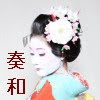
[COLOR]
Red, Yellow, Green, Gold
[SIZE]
Momiji (Japanese Maple)leaf:Approximately 1.5 inches=4cm
Width of entire Kanzashi:Approximately 4.75inches=12cm
Height of entire Kanzashi:Approximately 4inches=10cm
Length of entire Kanzashi:Approximately 7=18cm
[MATERIAL]
Habutae(羽二重)silk dyed by Atelier Kanawa
Aluminum Hairpin made by Atelier Kanawa
Aluminum Chirikan/Ginbira
Metallic Yarn
[DESIGN]
* Momiji (Japanese Maple) Tsumami Kanzashi for Maiko-san during Autumn season.
* You can enjoy the beautiful color change of the Momiji.
* This design can be found exclusively at Atelier Kanawa. Please don't miss it (^-^)
* The Chirikan/Ginbira beautifully swing according to your movement. You will love it!
[ATELIER KANAWA'S TSUMAMI KANZASHI CAREER]
Atelier Kanawa has been making both traditional & modern Tsumami Kanzashi since 2004. In the Summer of 2007, she was accepted as a private pupil and was professionally trained by one of the ONLY 15 acknowledged Tsumami Kanzashi artisans in the whole world.
[ABOUT HABUTAE(羽二重)SILK]
A plain woven silk textile of authentic Japanese vintage Kimono.
Habutae silk has a very smooth textures as soft, light and shiny, so they are used as Kimono linings. In Japan, we say "the best silk starts with Habutae and also ends with Habutae". Habutae silk proudly represents Japan.
[ABOUT TSUMAMI KANZASHI]
TSUMAMI (pinching) is the technique which to pinch/pick up a two dimensional piece of silk fabric to construct a three dimensional object. TSUMAMI consists of only two types of method called MARU-TSUMAMI (round pinching) and KEN-TSUMAMI (sword pinching).
Traditionally, we use Habutae silk to make TSUMAMI, but there is an artisan who uses Chirimen silk. Atelier Kanawa uses both and some other types of silk:)
Since the middle of Edo period(1603-1867), this handcraft technique has been traditionally utilized by maidservants in the imperial court as their hobby. Eventually, this beautiful technique was recognized by the Japanese society, then it began to be used to produce KANZASHI hairpins, sticks, combs and so on. You can see TSUMAMI KANZASHI in Ukiyoe picture. During that time period, Beethoven was quite active in Music industry.
Today, not only MAIKO wear them, but they are worn by Japanese women for new year celebration, celebration for children called "shichi go san", a coming-of-age ceremony, wedding, and those people who perform traditional Japanese dance.
TSUMAMI KANZASHI are made to show the beauty of four seasons. For example, MAIKO wear plum flower in February, cherry blossom in April, and chrysanthemum in October.
Today, there are ONLY 15 acknowledged artisans of TSUMAMI KANZASHI in the whole world. They don't really have anybody who will carry out this traditional art. I will take a class from one of them sometimes this year because I strongly would like to preserve this artwork and carry this out to the future generation:) IT MEANS A LOT TO ME TO HAVE YOUR PURCHASE because YOU ARE SUPPORTING US and YOUR PURCHASE COULD BE A VERY PRECIOUS CULTURAL HERITAGE.
[ABOUT GEISHA, GEIKO, MAIKO, OIRAN]
People tend to have a hard time distinguishing MAIKO, GEIKO, GEISHA, and OIRAN. So here are the descriptions about them for you.
MAIKO who wear these beautiful TSUMAMI KANZASHI are the age of between 15-20 years old young girls to add to the fun to banquet by singing, dancing, and playing Shamisen. They are under the training to become GEIKO.
GEIKO are advanced version of MAIKO that you can become after 5 years of training. They also add to the fun to banquet by singing, dancing, and playing Shamisen.
Both MAIKO & GEIKO are registered in "Okiya" in "Hana-machi" in Kyoto, such as Gion, and sent to "Ocha-ya".
GEISHA means a person who entertains with her artistic skills. GEI means art, SHA means a person in Japanese.
The root of GEISHA goes back to Heian era. There were harlots and Shira Byoushi performing songs & dances that were in fashion during that time period. Eventually war era started so they had to disappear. But peaceful Edo period came. The waitresses at Mizu-Chaya for visitor of the shrine/temple in Kyoto imitated Kabuki, then performed Shamisen and dance.
This custom was handed down to Edo(Tokyo of today) and gradually formed the style of GEISHA.
Today, GEISHA add to the fun to banquet by singing, dancing, and playing Shamisen. Even though GEISHA system was constructed in a licensed quarters, they are strictly distinguished from harlot. For example, they wear Tabi socks (harlots don't wear Tabi) and hold the side of Kimono by folding to the left so that the man can't slide their hands into GEISHA's kimono.
OIRAN is the highest rank of harlot in a licensed quarters, with the highest education of classical scholar, calligraphy, tea ceremony, a 31-syllable Japanese poem, Shamisen, the game of go, and also entertainment accomplishment. In order to be steady with OIRAN, men needed to spend a vast sum of money.

